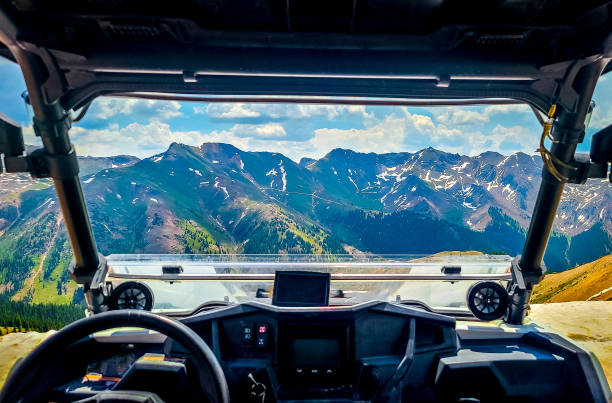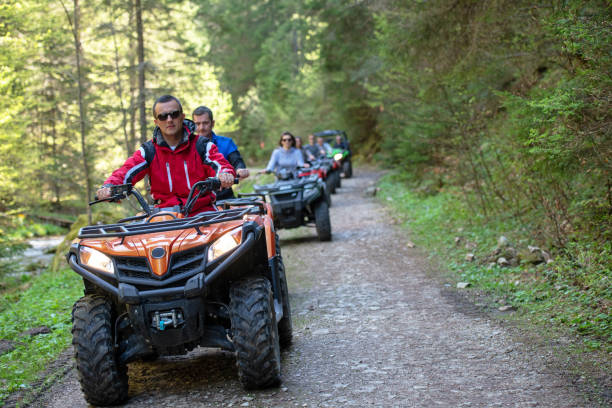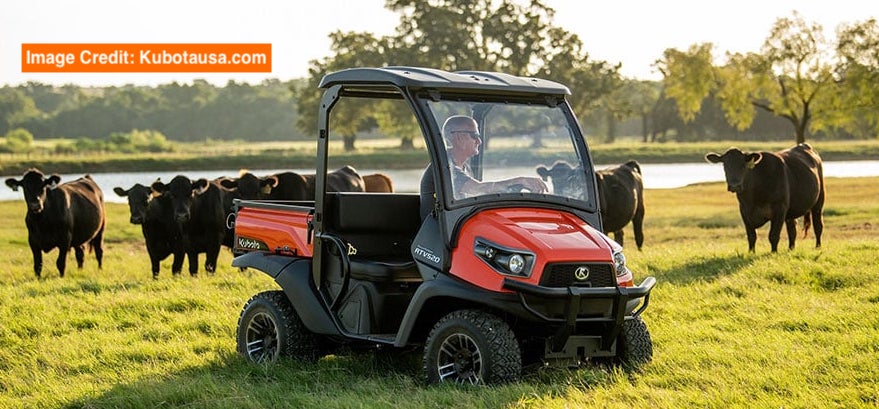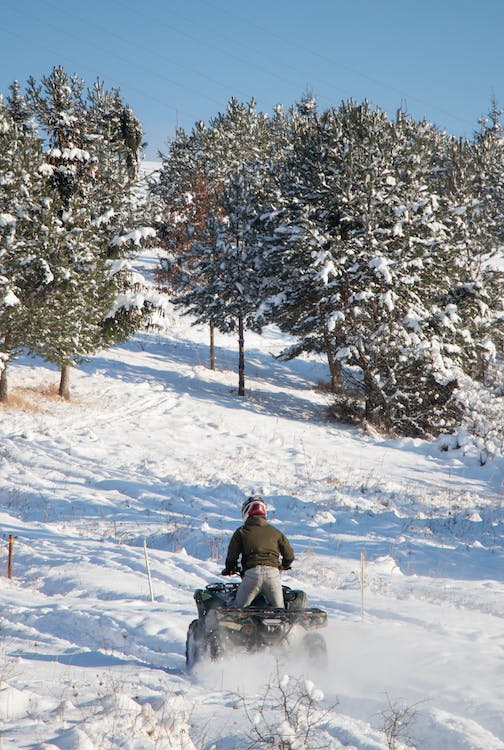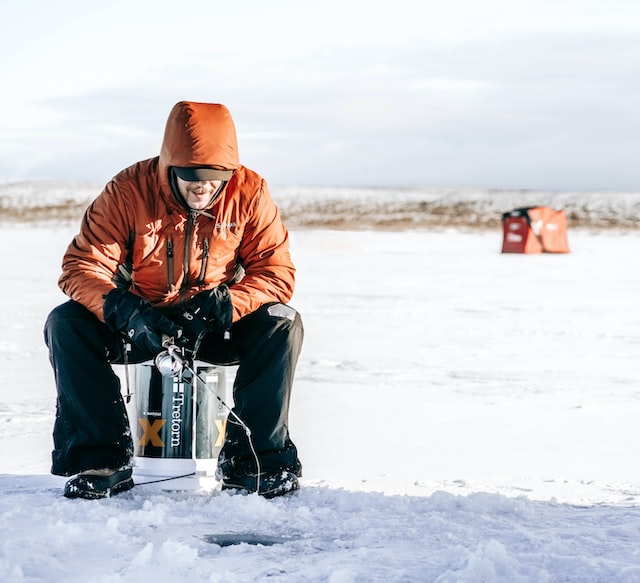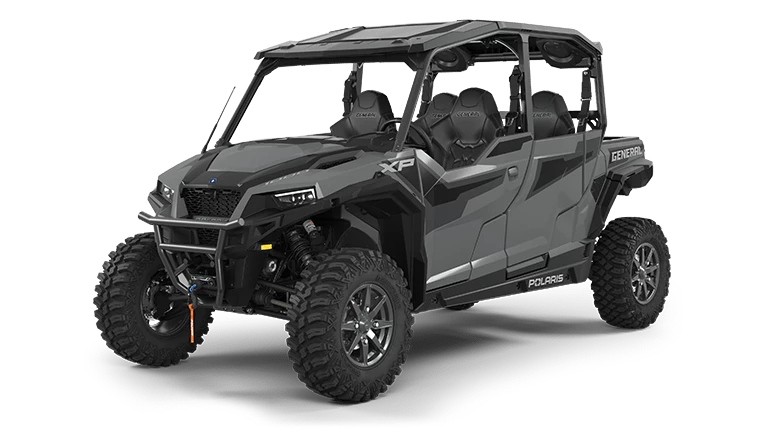As an Amazon Associate I may earn a commission from qualifying purchases at no additional cost to you.
ATVs and Side by Sides offer exhilarating adventures for those seeking to explore rugged terrains and diverse landscapes. While the thrill of riding is undeniable, maintaining the balance between recreation and conservation is crucial.
Practicing proper trail etiquette not only enhances the experience for all riders but also helps preserve the environment for future use.

Responsible trail behavior involves understanding and respecting shared spaces, ensuring minimal impact on natural settings. Riders should stay on designated trails, yield to hikers and equestrians, and maintain appropriate speeds.
These actions promote safety and protect native flora and fauna.
Conservation efforts extend beyond the trails themselves. Regularly inspecting and maintaining vehicles prevents environmental harm. By following these guidelines, enthusiasts can enjoy their rides while contributing to the preservation of natural resources.
Understanding ATVs and Side by Sides
ATVs and side by sides, though often confused, differ fundamentally in design and utility. Both vehicles serve unique roles in recreation and work-related tasks, offering varied features and capabilities.
Differentiating ATVs and Side by Sides
ATVs are typically smaller, single-rider vehicles designed for rough-terrain travel. Riders straddle the seat and use handlebars for steering.
Side by sides (UTVs), conversely, accommodate multiple passengers seated side by side and come with a steering wheel and seat belts, providing increased safety and comfort.
ATVs are often favored for agility and speed in sport. UTVs offer more cargo space and towing capacity, making them preferable for work settings. The choice largely depends on the purpose, with ATVs being adept for quick maneuvering and side by sides offering practicality for group travel and utility work.
An Overview of All-Terrain Vehicles (ATVs)
All-Terrain Vehicles, or ATVs, are known for their ability to traverse a variety of landscapes. Equipped with wide tires, they provide substantial traction and balance.
ATVs come in various sizes and engine capacities, often ranging from 50cc for youth models to 1000cc for more powerful types.
Their lightweight nature allows easy navigation of narrow, winding trails. Enthusiasts appreciate them for motorsports, such as racing and trail riding.
ATVs are versatile, suitable for farmers, hunters, and outdoor adventurers. Additionally, their smaller frame allows transport via standard truck beds or small trailers, enhancing their convenience for those on the move.
The Basics of Utility Task Vehicles (UTVs)
Utility Task Vehicles (UTVs), commonly referred to as side by sides, offer multipurpose functionality. Featuring a robust frame, UTVs accommodate several occupants and load space for tools or equipment.
Often larger and heavier than ATVs, UTVs are designed for stability and utility.
They excel in handling rough terrain while ensuring passenger safety, making them ideal for outdoor worksite operations. UTVs are frequently utilized in landscaping, construction, and agriculture. Features such as four-wheel drive, roll cages, and storage compartments enhance their appeal for diverse tasks. With numerous models available, buyers can select vehicles tailored to specific needs, from recreational use to heavy-duty labor.
Pre-ride Preparation
Before hitting the trails with an ATV or side-by-side, it’s crucial to undertake thorough preparation to ensure safety and enjoyment. Essential tasks include selecting proper safety gear, understanding the value of ATV safety courses, and conducting a meticulous check of the vehicle.
Selecting the Right Safety Gear
Choosing the correct safety gear is paramount for any ATV or UTV rider. A well-fitted helmet is non-negotiable, providing head protection in the event of an accident.
Riders should look for helmets that meet industry standards, such as DOT or Snell certification. Equally important are goggles to shield the eyes from dust and debris.
Protective gear extends beyond helmets and goggles. Riders should wear gloves for better grip and protection, sturdy boots to protect feet and ankles, and long sleeves and pants to minimize scratches from branches. Quality materials like reinforced textiles or leather are preferred.
An investment in robust protective gear can prevent injuries and enhance riding confidence.
Importance of ATV Safety Courses
Participating in ATV safety courses is highly beneficial for riders of all experience levels. These courses teach critical skills such as maneuvering, braking, and emergency handling.
Both new and seasoned riders gain significant insight from structured instruction delivered by professionals.
Safety courses often highlight local laws and regulations, ensuring that riders are compliant when venturing out. They also focus on responsible riding techniques, promoting environmental conservation and trail etiquette.
Enrolling in a certified safety course boosts a rider’s capability and awareness, paving the way for a safer and more enjoyable riding experience.
Checking Your Vehicle Before Riding
Conducting a pre-ride vehicle check is essential to prevent breakdowns and ensure safety. Key areas to inspect include tires for proper inflation and damage, ensuring optimal traction.
Fluid levels such as oil and coolant should be checked and topped off if necessary, to maintain the vehicle’s performance.
Riders should also inspect the brakes and controls, ensuring they function smoothly. Testing lights and signals adds another layer of safety, especially in low-visibility conditions. Finally, securing any loose parts or accessories prevents potential hazards on the trail.
This proactive approach can make the difference between a thrilling adventure and an avoidable mishap.
Essential Trail Etiquette
Adhering to proper trail etiquette is crucial for ensuring safety and environmental preservation when traversing ATV and side-by-side trails. This includes using designated trails, maintaining safe speeds, and respecting fellow trail users.
Riding on Designated Trails
Following designated trails helps protect the surrounding environment and maintains the integrity of the landscape. Riders should consult maps and trail signs to ensure compliance with route guidelines.
Riding off designated pathways can damage vegetation and disrupt wildlife habitats.
Trail markers are important for navigating legally approved paths. It helps preserve nature while minimizing negative impact. Responsible riders understand that staying on paths is crucial to maintain trail access and safety for everyone.
Maintaining a Safe Speed
Maintaining a safe speed is essential for avoiding accidents and ensuring a smooth experience on ATV trails. Fluctuating terrain and trail visibility require riders to adjust their speeds accordingly.
Speed limits are generally marked and should always be observed to prevent harm to themselves or others.
Riders should remain vigilant and slow down near blind curves or when visibility is poor. Proper judgment and consideration for trail conditions help to keep the trail safe and accessible for everyone.
Respect for Other Trail Users
Showing respect to all trail users, including hikers and cyclists, is a vital part of trail etiquette. Communicating effectively helps avoid misunderstandings on shared trails.
Riders should yield the trail to non-motorized users and slow down when approaching them.
Noise levels should be minimized to maintain the serenity of nature. Proper courtesy involves acknowledging others on the trail and maintaining safe distances. Being considerate ensures that everyone can enjoy the trail in harmony.
Conservation and Environmental Responsibility
Conservation and environmental responsibility are critical when using ATV and side by side vehicles. Users should focus on minimizing environmental impact, safeguarding wildlife by staying on marked trails, and adhering to Leave No Trace principles to ensure that natural habitats are preserved for future generations.
Minimizing Environmental Impact
ATV enthusiasts can significantly reduce their environmental footprint by steering clear of sensitive areas, such as wetlands and meadows, which can be easily damaged.
Choosing to ride on designated trails helps to limit soil erosion and protect fragile ecosystems. Drivers should also be mindful of speed to prevent scattering soil and plant life.
Regular maintenance of vehicles is vital. Properly functioning ATVs emit less noise and pollution. Engine tune-ups and checking for oil leaks contribute to minimizing pollution.
Additionally, riders should avoid altering trails or creating new paths to prevent habitat disruption. Bringing a trash bag to collect litter ensures natural areas remain clean.
Staying on Trails to Protect Wildlife
Staying on designated trails prevents the destruction of wildlife habitats. These trails are specifically designed to minimize disturbances to animal populations.
When riders venture off these paths, they risk destroying nests, burrows, and other vital habitat structures essential for local species’ survival.
Wildlife can be disrupted by noise and human presence. By restricting activities to marked trails, ATV users provide animals with a refuge from disturbances, promoting their well-being.
Education and awareness emphasize the importance of respecting these habitats. Riders should watch out for trail signs and respect seasonal closures that protect breeding or migratory species.
Leave No Trace Principles
Adopting the Leave No Trace principles helps preserve natural landscapes. This involves packing out everything you bring in, including waste and packaging, leaving the environment unspoiled.
Maintaining this mindset is crucial for conservation efforts on ATV trails. Respect for nature’s sounds by keeping noise levels low helps maintain tranquility.
Campfires should be minimized and built only in established fire rings to prevent damage. Fires not only scar the land but can spark uncontrolled blazes if not managed properly.
Educating others about these principles can foster a broader culture of environmental responsibility in the ATV community. By doing so, enthusiasts contribute to sustainable trail use.
Safety for Youth Riders

Safety is a top priority when allowing children to ride ATVs. Key factors include selecting a suitable vehicle, ensuring adult supervision, and considering formal safety education.
Choosing the Right ATV for Youth
Selecting the right ATV involves matching the vehicle’s size and engine capacity to the child’s age and experience.
Engine Size Recommendations:
- Children aged under 6: No ATV recommended
- Ages 6-11: Up to 70cc
- Ages 12-15: 70cc to 90cc
- Ages 16+: 90cc+
Proper fit ensures the youth can comfortably reach all controls while seated. It’s crucial for youth ATVs to have speed limiters or adjustable throttle mechanisms to control power output.
Additionally, wearing helmets and protective gear is non-negotiable for safety.
The Role of Active Supervision
Active supervision plays a critical role in ensuring the safety of young riders.
Supervision by an adult who understands basic ATV operation and can step in when necessary is ideal.
Supervisors must maintain an observable distance and intervene when any practices become unsafe.
Checklist for Supervisors:
- Ensure helmets and protective gear are worn
- Confirm weather conditions are safe
- Verify trails are appropriate for the youth’s skill level
Engagement through communication is also vital—consistently offering guidance and feedback ensures the child gains valuable experience while staying safe.
Youth ATV Riding Safety Courses
Youth ATV safety courses provide structured learning environments focused on responsible riding practices.
These courses cover essential skills, including starting, stopping, negotiating obstacles, and understanding terrain variables.
Safety courses often involve hands-on practice in controlled environments, leading to better risk assessment and decision-making when riding in real-world settings. They also instill the importance of helmet use and reinforce other protective gear requirements.
Course Benefits:
- Increased awareness of ATV safety issues
- Interaction with trained instructors
- Certification on course completion
Participation in these programs reinforces a lifelong commitment to safe riding habits.
Advanced Riding Techniques
Operating ATVs and UTVs efficiently requires mastering specific advanced techniques.
Riders need to adapt to varying terrains and navigate turns and obstacles skillfully. These skills ensure safety and enhance the experience.
Handling Different Terrains
Different terrains present unique challenges to ATV and UTV riders.
On rocky paths, maintaining a steady throttle is crucial to prevent jerking.
Sand dunes require riders to keep momentum by avoiding sudden stops. When dealing with muddy areas, lower tire pressure offers better grip and control.
Steep hills demand careful throttle management and balance to prevent rollovers. Experience helps refine these techniques, but practice and caution are essential for safety.
Mastering Turns and Obstacles
Navigating turns involves proper body positioning and throttle control.
When turning, riders should lean into the turn to maintain balance, while reducing speed before entering the curve.
Approaching obstacles requires anticipation and precision. Riders need to stand on foot pegs for stability and use slight throttle for controlled impacts.
Avoid sudden movements to maintain composure and prevent tipping. Mastery of these techniques enhances both safety and riding pleasure.
Riding Gear and Protection

Protective gear is essential for enjoyable and safe off-road adventures. Riders should prioritize using DOT-certified helmets and effective eye protection to significantly reduce the risk of injury.
Head Protection: DOT-Certified Helmets
Proper head protection is crucial. DOT-certified helmets meet specific safety standards, ensuring a higher level of protection during impacts.
These helmets undergo rigorous testing to verify their resistance to penetration and impact absorption. Riders should choose helmets that fit snugly and cover the entire head, like full-face helmets, which provide added jaw protection.
It’s vital to inspect helmets regularly for any signs of damage before each ride. Replacing them after an impact or every five years helps maintain their protective capabilities. Ensuring comfort and a secure fit contributes to better focus and comfort while riding.
Eye Protection: Goggles and Face Shields
Eye protection is necessary to guard against dust, debris, and wind.
Goggles offer an excellent seal around the eyes, preventing particles from impairing vision. Features such as anti-fogging lenses and UV protection enhance visibility and protect against sun damage.
Face shields attached to helmets can provide additional protection and ease of use. Riders should choose products that fit well with their helmets and avoid using scratched or damaged gear.
Properly maintaining lenses and using clear versions in low-light conditions ensures optimal vision. Adjustable straps on goggles also improve comfort during long rides, ensuring they stay secure even on bumpy trails.
Trail Maintenance and Community Involvement

Maintaining ATV trails requires community collaboration and commitment.
Trail enthusiasts often engage in clean-up efforts and support local organizations dedicated to conservation and upkeep.
Volunteering for Trail Clean-Up
Trail clean-up events play a vital role in preserving the integrity of ATV trails.
Volunteers remove litter, repair pathways, and address erosion issues, ensuring a safe and enjoyable experience for all users. Community members often organize these events, bringing together enthusiasts who share a passion for environmental conservation.
Participation in clean-up activities fosters a sense of responsibility among riders and reinforces the importance of preserving natural landscapes. By dedicating just a few weekends per year, volunteers make a significant impact on trail conditions and the surrounding environment. Information about clean-up days is typically available through local ATV clubs or social media platforms, encouraging broad community involvement.
Supporting Local Trail Maintenance Organizations
Local trail maintenance organizations are essential to the continued sustainability of ATV pathways. These groups work tirelessly to monitor trail conditions and ensure safe usage.
Supporting these organizations through membership, donations, or active participation amplifies their efforts in maintaining and expanding trail networks. Partnerships with these organizations also increase access to educational opportunities about sustainable riding practices.
Many organizations hold workshops and training sessions focusing on responsible use and conservation measures. Enthusiasts can contribute by attending these events or volunteering their skills to assist with organizational tasks.
By supporting these groups, individuals contribute to both trail preservation and the broader goal of ensuring access to natural environments for future generations.

